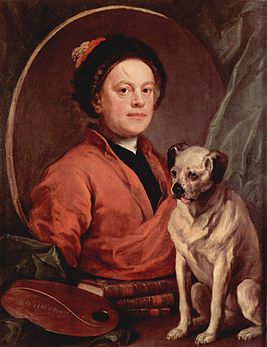

English graphic artist and painter, who became famous for his brilliant satirical works, William Hogarth – a vivid example of diligence, perseverance and talent. He was born on November 10, 1697 in a very poor family. The life of his father, Richard Hogarth, was extremely unsuccessful, he even spent 4 years in a debt prison. William’s mother was selling drugs, but it was not profitable. Six of the nine Hogart children did not live to be 10 years old, and William became the first surviving child. Heavy childhood left an imprint on the personality of the future artist, making him stubborn and purposeful.
At school, William Hogarth showed the ability to draw, but other subjects were given to him very hard. At the age of 16, he decided to quit his studies and entered the apprenticeship with an engraver for silver. Seven years later, William Hogarth opened his own workshop in the parental home. This idea was successful, engravings and illustrations brought a big income, but the artist dreamed of the artist’s laurels, and in 1724 he entered the discipleship of Sir James Thornhill, the famous master of historical painting.
In addition, William Hogarth was fond of portraits, but his work can not be called parade. They are more like genre scenes. A good example is the “Portrait of Garrick with his wife,” where the couple do not pose in the classical view of the time, but as if captured by the artist by surprise.
The paintings and engravings of William Hogarth are very rich in meaning, they have a hero and a story. Hogarth liked moralizing stories, and he himself created several such cycles of paintings called “Career Mota” and “Fashion Marriage.”
All the works were available in the form of engravings and sold well. This made the artist think about copyrights in order to stop producing counterfeit sheets. The “Hogarth Act”, which gives authors the exclusive rights to their products for 14 years, was adopted by Parliament in 1735.
William Hogarth died unexpectedly of an aneurysm, on October 25, 1764, and was buried in Chiswick. And the life of the artist left an imprint in the further development of his work. For example, seven of the eight engravings of the series “Career Mota” two hundred years after its creation formed the basis of the ballet of the Scottish singer, actor and composer Gavin Gordon. The production was carried out in 1935 by the choreographer Ninet De Valois. In 1951, Igor Stravinsky wrote the opera The Adventures of the Rake under the influence of Hogarth’s work. In 1946 on the screens there was an American feature film “Bedlam” directed by Mark Robson, whose creative team was inspired by Hogarth’s paintings and engravings.
Image: Hogarth William. Soon after the wedding. 1743 (National Gallery, London).